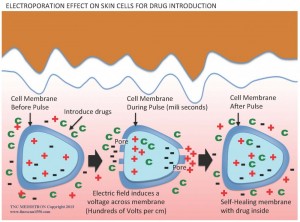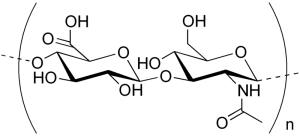Treatment for pushing nutrients in the Dermis without injection.

It is used in molecular biology as a way of introducing some substance
into a cell, such as Retinoic Acid (Vitamin A), Hyaluronic Acid and
Ascorbic Acid (Vitamin C).
Electroporation is a noninvasive alternative to conventional mesotherapy, so it has been called the virtual mesotherapy without needles (painless procedure) and allows the introduction of localized substances. The cell’s membrane is temporarily altered by electroporation (intermitent fields of more than 200volts/cm2), which causes opening of intracellular channels and enabling the penetration of active electroporated substances. Electroporation also opens thin channels in the epidermis through the intercellular space lipids. This approach is perhaps the most important in the medical-aesthetic applications of this technology, as it allows the passage of substances through the skin.
Recommended Nutrients

Retinoic Acid for Your Skin
Retinoic acid is the active form of vitamin A in the skin and the “gold standard” in anti-aging skin care. Topical retinoic acid treats fine wrinkles, age spots, and rough skin caused by sun exposure. In a study published in the Journal of Dermatological Science , researchers found that treatment with retinoic acid restored the elastic fibers that keep skin taut, and reduced the appearance of wrinkles.
Retinoic acid comes in gel, cream and liquid forms, which are typically used once a day. Although dermatologists used to believe that retinoic acid made the skin more sensitive to the sun, they now know that it actually protects against further sun damage.

Vitamins C for Your Skin
Research has found that vitamins C and E, as well as selenium, can help protect the skin against sun damage and skin cancer. And they may actually reverse some of the discoloration and wrinkles associated with aging. These antioxidants work by speeding up the skin’s natural repair systems and by directly inhibiting further damage, says Karen E. Burke, MD, PhD, of the Mount Sinai School of Medicine’s department of dermatology.

Hyaluronic Acid: Moisturizing and Fill for Your Skin
Is obtained by fermentation of substrates of vegetable origin.Has the ability to retain water increasing 30 times its size, so it is able to fill wrinkles. Gives skin exceptional lubricity and healthy. Inclusion in moisturizers and improves the effectiveness of cosmetic quality thereof increases.
It is an essential component of skin tissues. Over the years causing decreases, sagging, wrinkles and dehydration. It gives off skins, stressed, dry, oily to dry, prevents stretch marks. Found in many cosmetics called “filler”.
The treatments will take around 30 minutes total, no particular cares after the treatment, there is no topic anesthetic because is painless.
Results will last around 6 months, all the substances applied are known to our bodies, and therefore there are no risks of adverse reactions or rejections.





